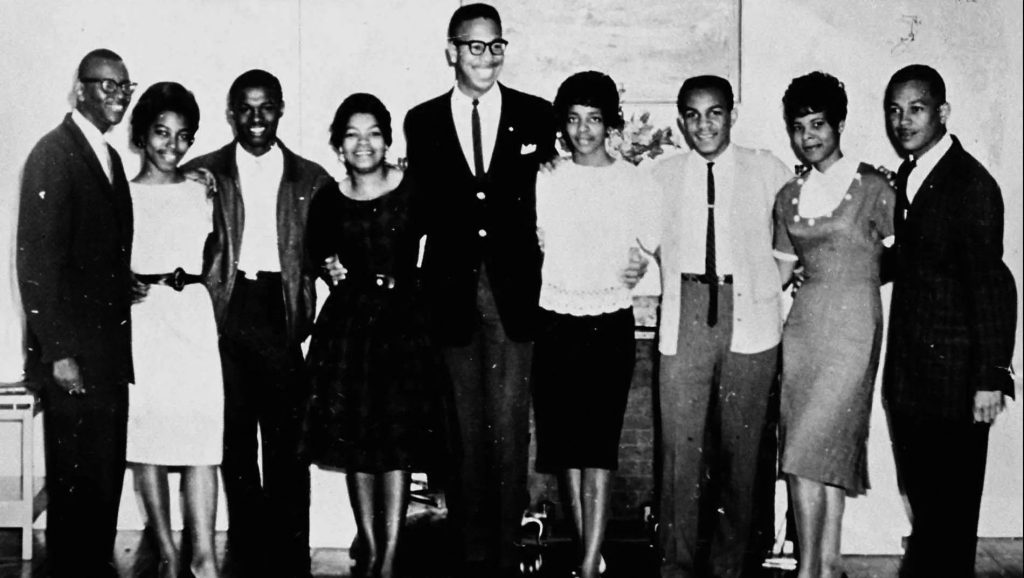Reprint from October 13, 2011; Tougaloo Nine honored at 28th Annual Hamer Institute Symposium
Editor’s note: Tougaloo College is known to many as the cradle of the Civil Rights Movement in Mississippi. Many of the exhibits and artifacts that are housed in the Mississippi Civil Rights Museum since its inception have a direct link to the institution. In fact, Tougaloo College was once considered among the places to house the civil rights museum because of its rich and storied history.
The podium that Martin Luther King Jr. spoke from still sits in Woodworth Chapel today. One of the first times Stokely Carmichael shouted “Black Power” was on the hallowed grounds of Tougaloo College. SNCC and CORE were mainstays on the campus. During that era, there was perhaps no single place that embodied the fight for civil rights or impacted the movement more than Tougaloo, which became a safe haven for civil rights leaders and the incubator for ideas and strategies that would ultimately change the world.
In 1961, nine Tougaloo students – Alfred Cook, Ethel Sawyer, Geraldine Edwards Hollis, Evelyn Pierce (deceased), Janice Jackson, Joseph Jackson Jr., Albert Lassiter, James “Sammy” Bradford, and Meredith Anding, Jr. (deceased) – demonstrated Black resistance in the historic sit-in, or read-in, at the old Jackson Municipal Library. These nine unsung heroes reminisced about their experiences at the 28th Annual Hamer Institute Symposium in 2011 which is recounted below by Jackson Advocate Contributing Editor Earnest McBride.
Their individual memories may be a bit hazy in recalling the finer details of what transpired on March 27, 1961. But they all remember that day as a great moment in history and as the beginning of the end of segregated public facilities in Mississippi. After 50 years of accumulated experience, nine different minds are expected to present some measure of disparity in recalling what happened such a long time before.
Tougaloo’s Woodworth Chapel, famous as the gathering place for legions of civil rights workers during the height of the movement in the 1960’s, became once again the center of action for the special program, “An Evening with the Tougaloo Nine,” presented by the 28th Annual Fannie Lou Hamer Institute Symposium.
Former Howard University President Joyce Ladner was the keynote speaker at Jackson State University the first evening of the two-day event. Ladner, who helped organize a sympathetic protest in support of the Tougaloo Nine in the days following the sit-in, was expelled in spring 1961 from JSU for her efforts. She enrolled at Tougaloo in the fall of 1961 and evolved as one of the most important members of SNCC’s voter registration drive.
During last week’s two-day remembrance of the Tougaloo Nine’s date with destiny at the Jackson Public Library in March of 1961, seven of the eight surviving nine reflected on the actions of Medgar Evers from very different perspectives.
Alfred Cook, now 73, recalled that Evers was under constraints from the national office of the NAACP that prevented him from launching direct action such as marches and demonstrations in early 1961, only six years after the famous Montgomery bus boycott began in 1955. The Tougaloo Nine were members of the college’s NAACP chapter. They did have some adult advisers, nevertheless, such as the Rev. John Mangrum, then chaplain at Tougaloo.
Cook, a sophomore at the time, recalls Medgar Evers as playing only a minor role in the planning and execution of the library within and had no direct role in preparing the students and monitoring them as they carried out their plan.
“Fifty years after the fact,” Cook said in reflecting on last Thursday’s gathering, “it was difficult for us to come out with complete consistency about how we came to organize around the action. It came about because of student activity on campus. Others stated that it came about because of Medgar Evers and the NAACP, which I totally disagree with. Medgar Evers had nothing to do with the Tougaloo Nine coming together. That was a student directed activity. We sought the advice of Medgar after we had developed, organized, chosen our site, and chosen the activity. We needed someone who could communicate with the news media, as a support. Tougaloo Chaplain John Mangrum also assumed that role. But he had been working with us quietly all along.”
One of the original Tougaloo Nine, Evelyn Pierce, a native of Laurel, has passed. Joseph Jackson, a resident of California, did not attend the ceremonies. Ms. Pierce’s family represented her at last Thursday’s honors.
Ethel Sawyer, a junior in 1961, was grateful for having had the opportunity to return to the site of one of the major turning points in history.
“I appreciated very much Tougaloo College and the Hamer Institute’s continued acknowledgement of the role of the Tougaloo Nine in the civil rights struggle,” Sawyer said. “It was a lovely time to meet with the students and the organizers of the event.”
James “Sammy” Bradford, a resident of the Tougaloo community today, recalls the adult support team in the greater Jackson community during the uncertain days following upon the library sit-in.
“After we entered the library, and began testing the system, we knew that we might get arrested,” Bradford said. “In fact, that was part of the reason we were there – expecting to get arrested. We had the support of people like the Rev. R.L.T. Smith, who had already made plans to put up their property for our bond. There were others I can’t remember right now, who had put up their personal properties and land. We just didn’t know how or if we were going to get out at the time.”
The nine students spent overnight in jail, a total of 36 hours incarcerated, Bradford says. The court hearing took place the day after their arrest. Attorneys Jack Young and R. Jess Brown represented the Tougaloo Nine, but they were not allowed to see their clients before the courtroom appearance, said Bradford. The Nine were charged with breach of the peace, fined $100 each, and given a year’s probation.
Although not a member of the Tougaloo Nine, Thomas Armstrong was a junior at Tougaloo at the time of the library sit-in. He recalls in his 1968 book “The Autobiography of a Freedom Rider” (2011) the widespread impact the work of the Tougaloo Nine and the campus in general made on the world around him.
“Tougaloo was a special place,” Armstrong says. “It nurtured the inquisitiveness of one’s soul. The faculty had the difficult task of instilling the college’s philosophy of the independence needed to function in a segregated society into the minds of poor, undereducated Black students. We learned that ‘now’ was the time to affect change.”
Armstrong, one of the first Tougaloo student activists to participate in the crusade for civil rights, came to the campus as a freshman in 1958. He played a major role in mustering support for the Freedom Riders and the Student Nonviolent Coordinating Committee voting registration drive. He later moved to Chicago, but remained active as a proponent of civil rights nevertheless.
“Tougaloo was a beacon shining on all dark corners of a segregated Mississippi,” Armstrong says. “And it was that light that was used by many of the foot soldiers to courageously navigate the dangerous roadways of hatred. While sitting on the grass under the old moss-draped oak trees on campus, planning the next protest with other schoolmates, we felt that we could change the world.”
Earnest McBride was Freshman Class President at Tougaloo 1960-1961.






